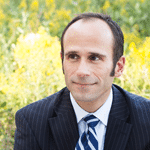
Doug Widener, director of community advancement for the USGBC, is working to bring separate chapters within one state together to form a single entity, as he did in Illinois.
Doug Widener is excited. As an industry, what’s become known as green building is still young, and for leaders such as Widener, who became the USGBC’s newest director of community advancement in August 2012, the industry’s youth means that it has infinite opportunity. “We’ve only scratched the surface,” Widener says. “As we diversify and get more involved in projects that are moving green building forward for all communities, we’re really going to start hitting that tipping point.”
I met up with Widener while he was in Chicago for a few days before going back to Washington, DC, then Orlando, Florida, and Columbus, Ohio, for his work with the USGBC. He lives in Chicago and picked to meet at a place he knows very well: the Peggy Notebaert Nature Museum, where he worked for 10 years before going to the USGBC.
At the nature museum we were surrounded by flowers and prairie grasses, and at first glance, his pinstriped, two-button suit and banded tie suggested a businessman out of his element. But after we shook hands and started talking, Widener looked very much at home at his old place of work. In the years he was there, he started as an educator, then became director of education, and finally worked as the vice president of education for the nature museum for four years before going on to be the first staff member for the then nascent Chicago chapter of the USGBC. Although soft-spoken, he is articulate and intelligent with the cool, contemplative demeanor of a dedicated professional.
Widener is most passionate when talking about how the successes, advancements, and programmatic shifts of the green-building industry have been—and continue to be—possible only through working with others. “There are 77 national USGBC chapters, and being in this new role with the USGBC helps me—and all of us—realize that we’re all on the same page,” Widener says. “I’ve been through a lot of ups and downs, and I want to take that experience to now help other chapters.”
The USGBC was originally formed in 1993, but it wasn’t until the green building industry boom in the early 2000s when myriad volunteer-run state chapters started to sprout up. That boom was partly fueled by a thriving building industry though the interest in green building came from the local grassroots support generated by the growing state chapters.
When Widener became the executive director of what was then USGBC-Chicago in 2006, he was the organization’s first staff member, but instead of coming from the building profession, he was joining via the nonprofit industry—a conceptual shift indicative of the USGBC’s dynamic role as a transforming agent in and beyond the green building industry.
Two years into his stint with USGBC-Chicago, Widener and the rest of the United States had to face the economic downturn. Aside from the obvious difficulties presented by the industry collapse, Widener and his board saw the challenge as an incentive to begin consolidating the separate Chicago and Central Illinois chapters to form USGBC-Illinois in 2009. Now that he is at the national level, Widener continues to promote consolidation of chapters in other states. “Florida has seven chapters, California has eight, Ohio has four,” Widener says. “We’re working on helping our chapters collaborate more closely so that if they don’t consolidate, they can at least work more closely together. We grew when the economy was great, but now we have to shrink a little bit to be more effective.”
In addition to his consolidation efforts, Widener also oversaw some major precedent-setting programs while with USGBC-Illinois, including the Regional Green Building Case Studies Project, a two-year, post-occupancy study concluded in 2010. The project was executed by USGBC-Illinois in partnership with the EPA and the City of Chicago analyzing the performance, costs, and benefits of 51 LEED projects in Illinois. Since the study was completed, it’s been replicated by other state chapters.
“I’ve been through a lot of ups and downs, and I want to take that experience to now help other chapters.”
DOUG WIDENER, USGBC
Widener’s leadership also led to Greenbuild being hosted twice in Chicago while he was head of USGBC-Illinois, during which time he also made recommendations under House Joint Resolution 45 for greening Illinois schools, created the Urban Open garden project, and formed a unique partnership with the Chicago Community Loan Fund and the Alliance for Environmental Sustainability to train affordable-housing providers in the area on green-building techniques. He also helped launch the Emerald Awards, which started in 2012 by honoring projects and leaders in the Illinois green-building industry.
“Illinois is currently the largest USGBC chapter by membership and in the top five for budget and staff, so Illinois is seen as a leader,” Widener says. And while he is still a chapter member, it was his leadership that now puts him on the national circuit, where he is currently overseeing a three-year national USGBC plan that was launched at the end of 2012 and encourages diversity and cohesion between national and state chapters.
“Everything in this three-year plan is focused on how to diversify the movement, how to dive deeper, how to be resilient, and how to get people engaged,” Widener says. “There are so many great ideas out in the chapter network, and our role will be to both identify great programs and help other chapters replicate them.”
Although the economy continues to test the strength of the industry, Widener believes every challenge presents an opportunity. As the green-building industry is now looking just as critically at existing buildings as it is at new projects, an aspect of Widener’s efforts detail the evaluation of extant assets for new possibilities.
“I think there’s a lot of untapped potential for further collaboration between the USGBC and its chapters,” Widener says. “We do a lot already, but we can do more.”

